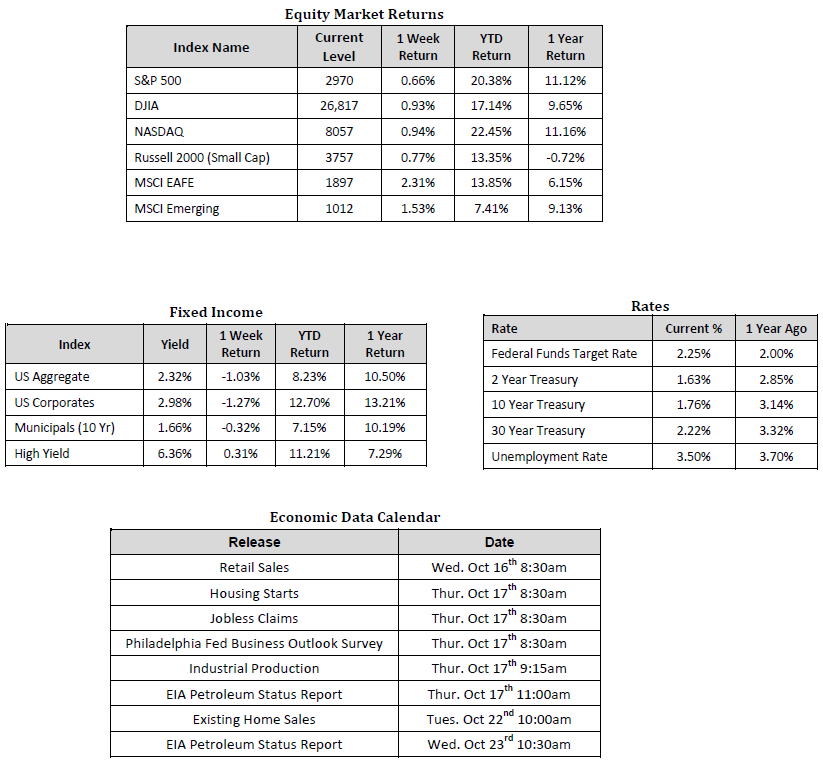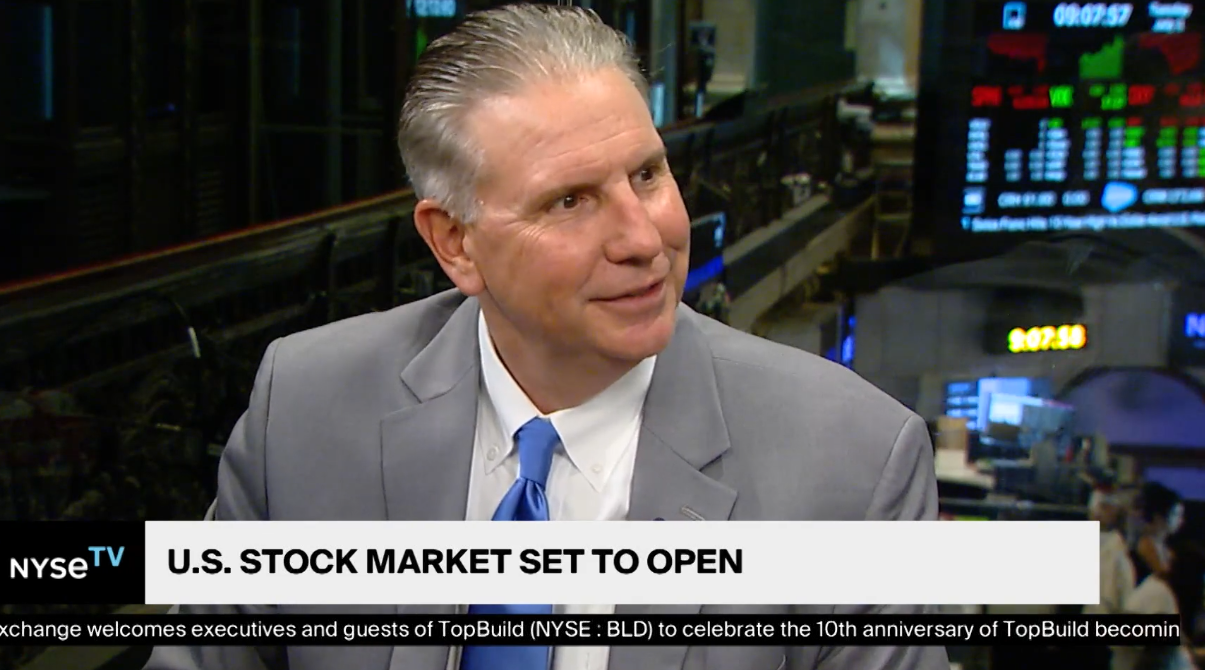
U.S./China Trade Agreement: Phase 1
Market Overview

Sources: Sources for data in tables: Equity Market and Fixed Income returns are from JP Morgan as of 10/11/19. Rates and Economic Calendar Data from Bloomberg as of 10/11/19. International developed markets measured by the MSCI EAFE Index, emerging markets measured by the MSCI EM Index. Sector performance is measured using GICS methodology.
Happening Now
Global equity markets finished last week higher in the aggregate after retreating for three consecutive weeks. In the U.S., the S&P 500 Index rallied to a level of 2970, representing a gain of 0.66%, while the Russell Midcap Index fell 0.83% for the week. The Russell 2000 Index, a measure of the Nation’s smallest publicly traded firms, followed suit with its own decline of 1.00%. On the international equities front, developed markets moved 2.31% higher, while emerging markets gained 1.53%. Finally, the 10 year U.S. Treasury yield finished out the week higher at 1.76%, after a previous string of weekly declines.
For over a year now, and what feels like a decade, we’ve discussed the ongoing trade dispute between the U.S. and China. If you’ve followed along you know that progress has been prematurely reported on several occasions, which has led equity markets to rally higher only to inevitably selloff. Naturally, we have reservations that this could happen again, but for the time being it appears that “Phase 1” of a multi-phase trade agreement has been reached. As of Monday morning, it has been reported that the U.S. has reached a verbal agreement with China, referred to by President Trump as “Phase 1”, though several media reports suggest that China may want to discuss further later this month.
So what does a potential “Phase 1” of this agreement entail? While nothing official has made its way into writing just yet, it appears that the U.S. will forgo implementing a planned October 15th tariff increase on Chinese goods, while China agrees to increase purchases of U.S. agriculture, offer more currency transparency, and allow U.S. financial services firms greater access to the Chinese market.
“Phase 1” is undoubtedly a step in the right direction, but it is our understanding that it is void of any mention of the intellectual property and forced technology transfer issues that are of core importance to the U.S. While we would expect those concerns to be hashed out in a future phase of the agreement, we don’t currently expect them to be concluded in the immediate future.
After nearly a year and a half of discussions between the U.S. and China, it is fair to say that negotiations rarely go according to plan and the time-frame for a final conclusion remains unclear. As a result, we continue to encourage investors to stay disciplined and work with experienced financial professionals to help manage their portfolios through various market cycles within an appropriately diversified framework that is consistent with their objectives, time-frame, and tolerance for risk.
Important Information and Disclaimers
Disclosures: Hennion & Walsh is the sponsor of SmartTrust® Unit Investment Trusts (UITs). For more information on SmartTrust® UITs, please visit www.smarttrustuit.com. The overview above is for informational purposes and is not an offer to sell or a solicitation of an offer to buy any SmartTrust® UITs. Investors should consider the Trust’s investment objective, risks, charges and expenses carefully before investing. The prospectus contains this and other information relevant to an investment in the Trust and investors should read the prospectus carefully before they invest.
Investing in foreign securities presents certain risks not associated with domestic investments, such as currency fluctuation, political and economic instability, and different accounting standards. This may result in greater share price volatility. These risks are heightened in emerging markets.
There are special risks associated with an investment in real estate, including credit risk, interest rate fluctuations and the impact of varied economic conditions. Distributions from REIT investments are taxed at the owner’s tax bracket.
The prices of small company and mid cap stocks are generally more volatile than large company stocks. They often involve higher risks because smaller companies may lack the management expertise, financial resources, product diversification and competitive strengths to endure adverse economic conditions.
Investing in commodities is not suitable for all investors. Exposure to the commodities markets may subject an investment to greater share price volatility than an investment in traditional equity or debt securities. Investments in commodities may be affected by changes in overall market movements, commodity index volatility, changes in interest rates or factors affecting a particular industry or commodity.
Products that invest in commodities may employ more complex strategies which may expose investors to additional risks.
Investing in fixed income securities involves certain risks such as market risk if sold prior to maturity and credit risk especially if investing in high yield bonds, which have lower ratings and are subject to greater volatility. All fixed income investments may be worth less than original cost upon redemption or maturity. Bond Prices fluctuate inversely to changes in interest rates. Therefore, a general rise in interest rates can result in the decline of the value of your investment.
Definitions
MSCI- EAFE: The Morgan Stanley Capital International Europe, Australasia and Far East Index, a free float-adjusted market capitalization index that is designed to measure developed-market equity performance, excluding the United States and Canada.
MSCI-Emerging Markets: The Morgan Stanley Capital International Emerging Market Index, is a free float-adjusted market capitalization index that is designed to measure the performance of global emerging markets of about 25 emerging economies.
Russell 3000: The Russell 3000 measures the performance of the 3000 largest US companies based on total market capitalization and represents about 98% of the investible US Equity market.
ML BOFA US Corp Mstr [Merill Lynch US Corporate Master]: The Merrill Lynch Corporate Master Market Index is a statistical composite tracking the performance of the entire US corporate bond market over time.
ML Muni Master [Merill Lynch US Corporate Master]: The Merrill Lynch Municipal Bond Master Index is a broad measure of the municipal fixed income market.
Investors cannot directly purchase any index.
LIBOR, London Interbank Offered Rate, is the rate of interest at which banks offer to lend money to one another in the wholesale money markets in London.
The Dow Jones Industrial Average is an unweighted index of 30 “blue-chip” industrial U.S. stocks.
The S&P Midcap 400 Index is a capitalization-weighted index measuring the performance of the mid-range sector of the U.S. stock market, and represents approximately 7% of the total market value of U.S. equities. Companies in the Index fall between S&P 500 Index and the S&P SmallCap 600 Index in size: between $1-4 billion.
DJ Equity REIT Index represents all publicly traded real estate investment trusts in the Dow Jones U.S. stock universe classified as Equity REITs according to the S&P Dow Jones Indices REIT Industry Classification Hierarchy. These companies are REITs that primarily own and operate income-producing real estate.



